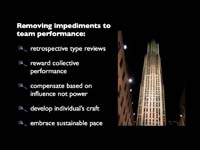 Dear consultant who uses “agile” as part of your brand,
Dear consultant who uses “agile” as part of your brand,
I am a possible customer who embraces agile principles, practices agile techniques and has done so for years.
I admire the tenacity and talent it takes to build a business in consulting.
The best of you offer your clients techniques, language and a way of thinking that can better lives and turn around companies: advising them in ways to change their own organizations, bolstering their courage to experiment, helping them learn to iteratively learn, inspiring them to foster teams, empower individual contributors, incrementally improve, and helping them grow past dependency on your services.
Here’s how I judge whether a thought leader is a worthy mentor:
- Your reputation among those of your peers I know and respect.
- Do you provide context/share credit: “This is where it originated, this is who popularized or researched it, this is who’s written well on it. This is my version of it.”
- Do you espouse principles: “This is about defining work that builds equity because it offers real benefit to end users and a way of working that entrusts individual contributors of diverse talents to collaborate within teams to deliver that benefit.”
- Are you frank: “Most companies who try this fail. Most managers who try this will not change their own behavior enough to allow their teams to succeed for them.”
- Do you embody the principles: “It is about your team(s). Not me. I do not have right answers only experience, a willingness to listen, and techniques to help us figure out what you need to do to help yourselves.”
Conversely, these are the bad smells:
- Celebrating the widespread adoption of “Agile” without acknowledging most “agile” adoptions are crap.
- Celebrating scale not individual team excellence.
- Focusing on techniques not principles as if “stories” and “iterations” were magic.
- Talking about software tools before disciplined engineering practice.
- Talking about “value” and “productivity” as if a leader’s understanding of these terms were not a/the major obstacle to their workers ability to perform.
- Jamming agile practices into a contradictory way of thinking: “Agile process manager” anyone?
- Coining new jargon for a slight spin on existing practices: It looks like a timebox, smells like a timebox, tastes like a timebox. “I call it creato-inno-rations™.”
- Putting yourself above the problem: Just because you were really good when you practiced doesn’t mean you are a brilliant coach. Just because you’re a brilliant coach doesn’t mean you can do my job better than me. Just because you can do my job better than me doesn’t mean paying you to not do my job provides my company value.
- Overheated claims of personal invention/Not giving credit to others. Sorry guys (and I mean guys), Mary Poppendieck was talking kanban and software development fifteen years ago. You’ve advanced the craft, you’re changing minds, and you may be very good at what you do but you are not Archimedes.
As a potential customer, I need your honest criticism, I am impressed by your ability to learn from others. I respect determination and humility more than bravado.
Give credit where credit is due and do exceptionally well.















